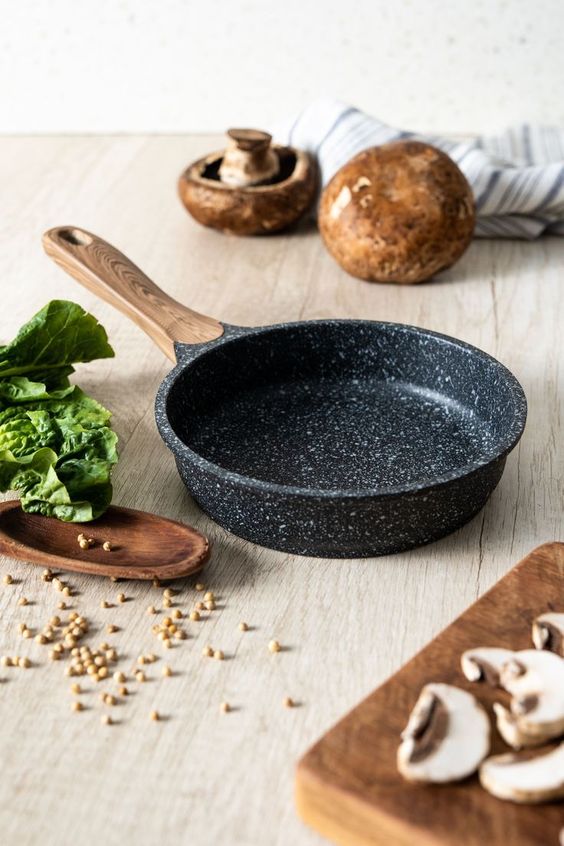Pans are the backbone of any kitchen, essential for a wide range of cooking techniques from sautéing and frying to baking and roasting. With so many types of pans available, choosing the right one for your culinary needs can be overwhelming. This guide will explore the various types of pans, their uses, materials, and care tips to help you make informed decisions and elevate your cooking game.
Types of Pans and Their Uses
- Frying Pan (Skillet)
- Uses: Ideal for frying, sautéing, and browning foods.
- Features: Typically has a flat bottom and flared sides.
- Sizes: Common sizes range from 8 to 12 inches.
- Sauté Pan
- Uses: Perfect for sautéing, searing, and reducing sauces.
- Features: Has a flat bottom with straight, taller sides to contain liquids.
- Sizes: Available in various sizes, typically from 3 to 5 quarts.
- Saucepan
- Uses: Ideal for making sauces, boiling, and simmering.
- Features: Has high, straight sides and a lid.
- Sizes: Common sizes range from 1 to 4 quarts.
- Stockpot
- Uses: Perfect for making soups, stocks, and boiling large quantities of food.
- Features: Tall sides and a large capacity.
- Sizes: Typically ranges from 6 to 20 quarts.
- Grill Pan
- Uses: Great for grilling indoors, ideal for meats, vegetables, and sandwiches.
- Features: Has ridges that mimic grill marks and allow fat to drain.
- Sizes: Usually around 10 to 12 inches.
- Roasting Pan
- Uses: Ideal for roasting meats, poultry, and vegetables.
- Features: Large, rectangular pan with low sides and often includes a rack.
- Sizes: Common sizes range from 14 to 18 inches.
- Baking Pan
- Uses: Used for baking cakes, brownies, and casseroles.
- Features: Comes in various shapes like rectangular, square, and round.
- Sizes: Typically 9×13 inches for rectangular, 8×8 inches for square, and 9 inches for round.
- Dutch Oven
- Uses: Versatile for braising, baking, and deep frying.
- Features: Heavy-duty pot with thick walls and a tight-fitting lid.
- Sizes: Common sizes range from 4 to 7 quarts.
Materials and Their Benefits
- Stainless Steel
- Benefits: Durable, non-reactive, and resistant to rust and corrosion.
- Ideal for: Browning, sautéing, and deglazing.
- Cast Iron
- Benefits: Excellent heat retention and even heating. Can be used on the stovetop and in the oven.
- Ideal for: Searing, frying, and baking.
- Non-Stick
- Benefits: Easy to clean and requires less oil for cooking.
- Ideal for: Cooking delicate foods like eggs and pancakes.
- Aluminum
- Benefits: Lightweight and excellent heat conductor.
- Ideal for: All-purpose cooking, often paired with a non-stick coating.
- Copper
- Benefits: Exceptional heat conductivity and precise temperature control.
- Ideal for: Sauces and delicate cooking.
- Carbon Steel
- Benefits: Heats up quickly and retains heat well.
- Ideal for: High-heat cooking, similar to cast iron but lighter.
Choosing the Right Pan
- Cooking Style: Consider what you cook most often. For example, if you fry frequently, a high-quality skillet is essential.
- Material: Match the material to your cooking needs. Stainless steel for versatility, non-stick for easy cleanup, cast iron for heat retention.
- Size: Ensure the pan size fits your typical portion sizes and stovetop burners.
- Maintenance: Consider how much effort you’re willing to put into cleaning and maintaining your pans. Cast iron requires seasoning, while stainless steel is low maintenance.
Caring for Your Pans
- Cleaning: Follow manufacturer’s instructions. Avoid harsh abrasives on non-stick surfaces. Cast iron should be cleaned without soap to maintain seasoning.
- Seasoning: Cast iron and carbon steel pans require regular seasoning to maintain their non-stick properties and prevent rust.
- Storage: Store pans properly to prevent damage. Use pan protectors or towels between stacked pans.
- Usage: Use appropriate utensils to prevent scratching, especially on non-stick surfaces. Wooden or silicone utensils are best.
